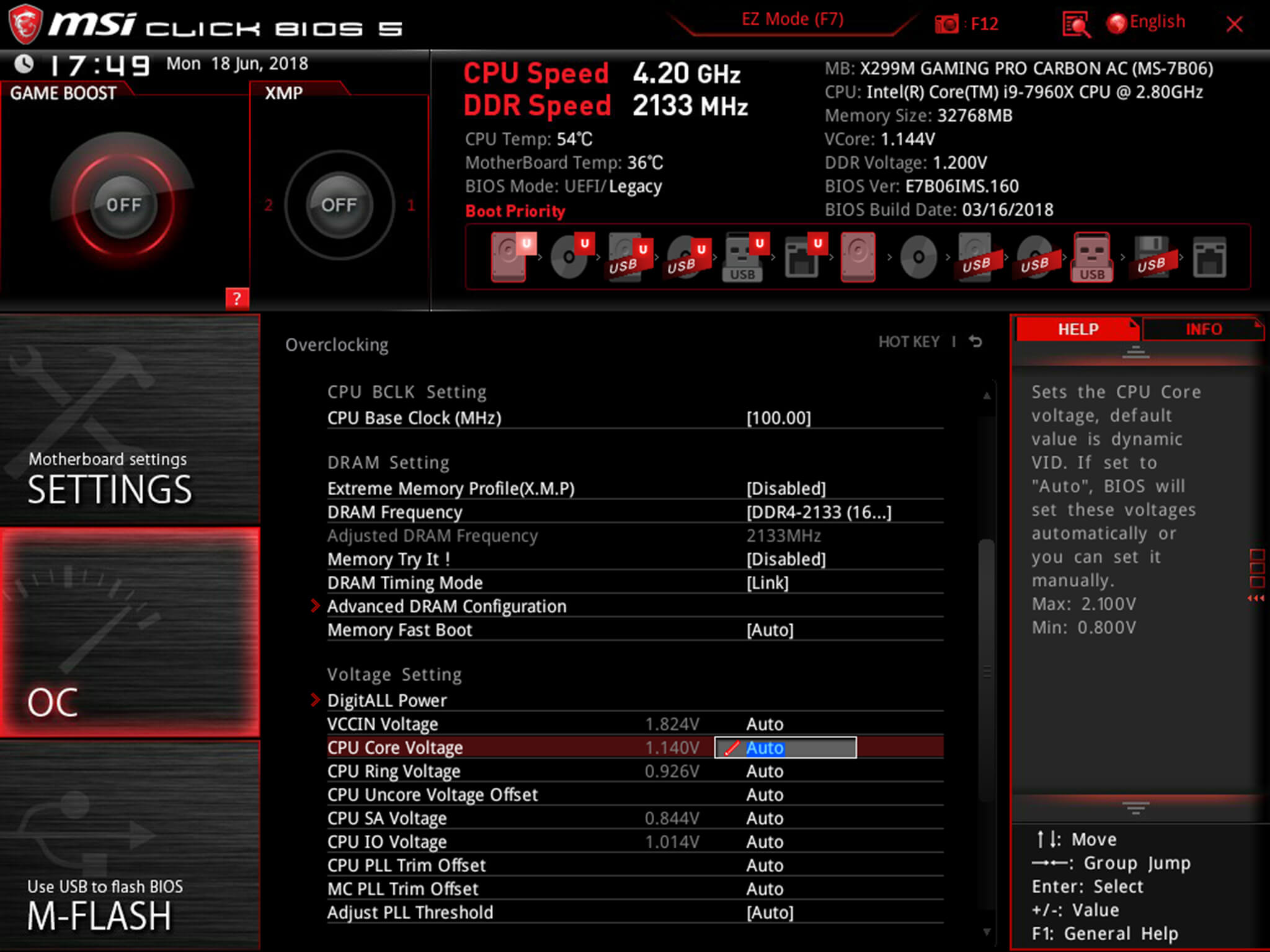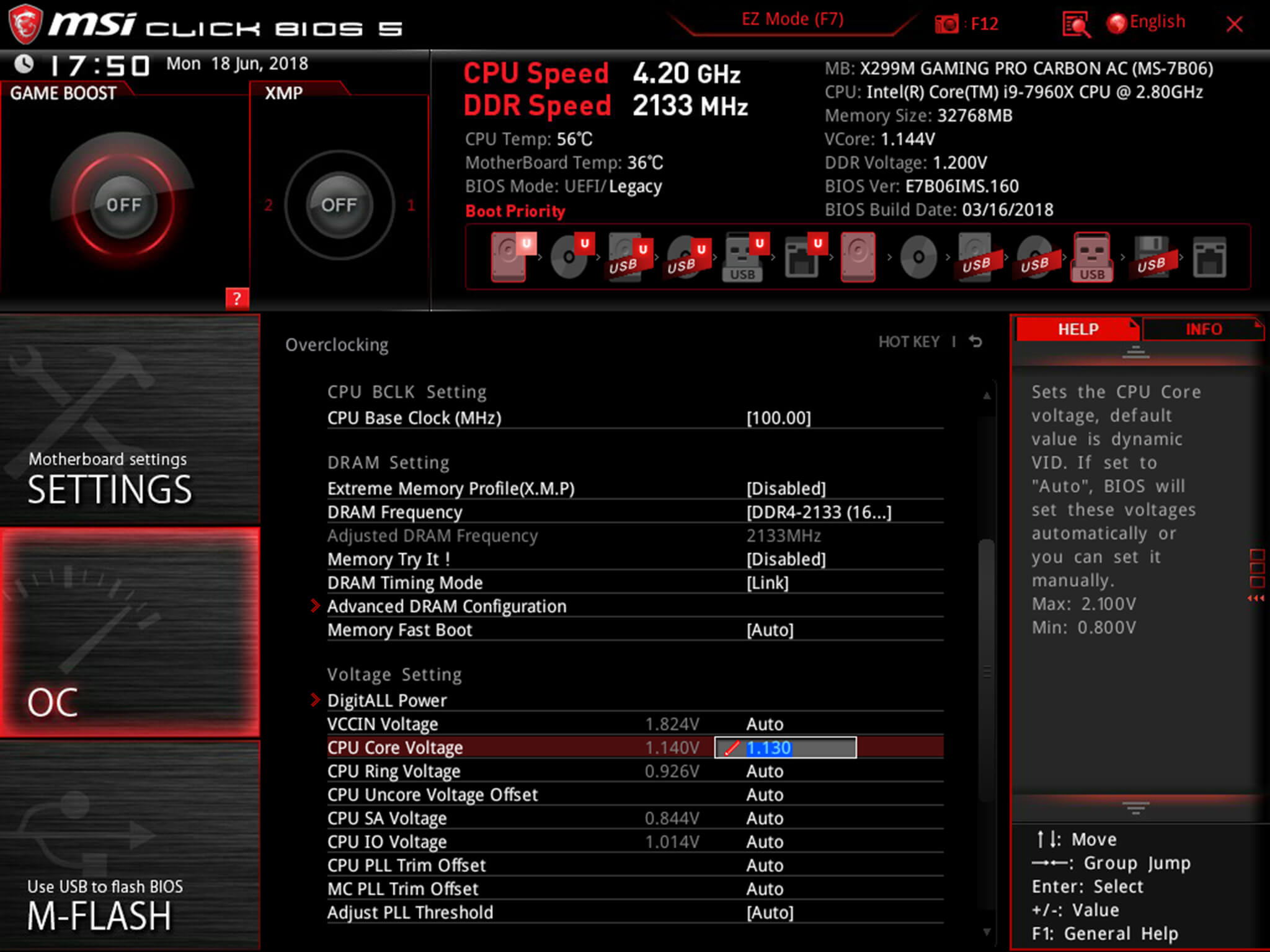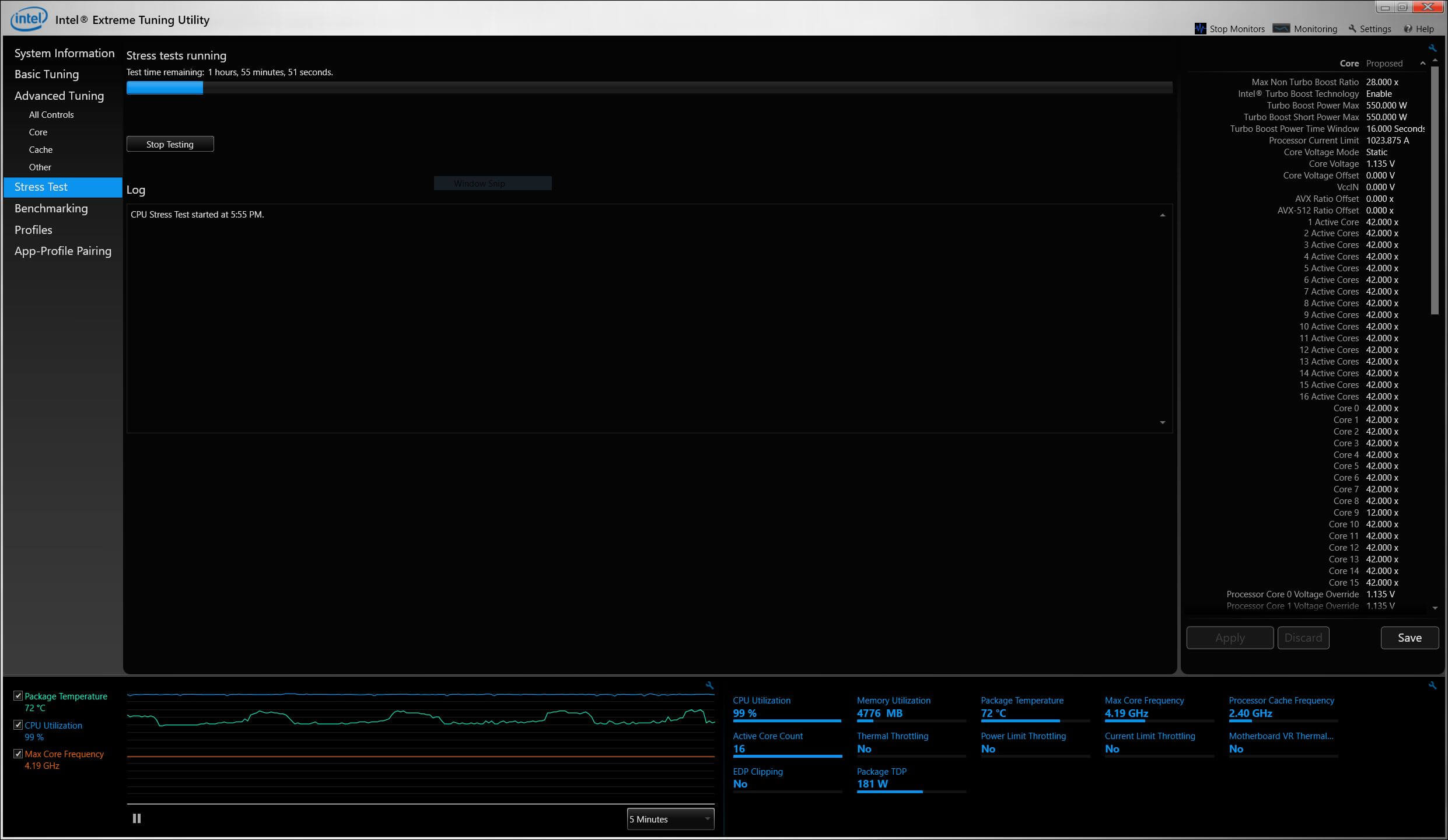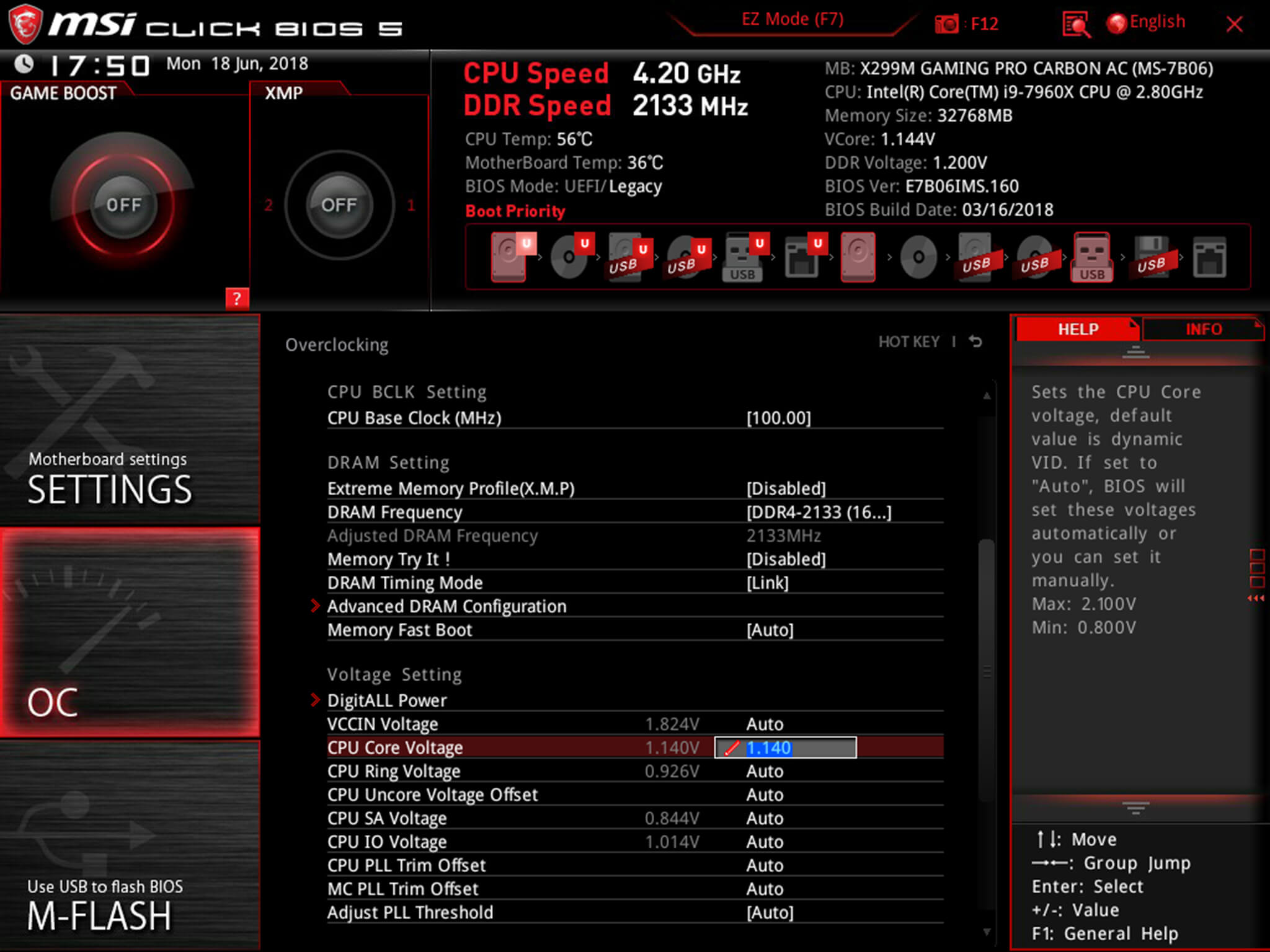The core voltage is different for each processor model, and while all CPUs of the same model have the same VID, not all samples maintain stability at the same clock speeds and Vcore due to slight variations in silicon quality. Every sample of the same CPU model is tested to maintain stability at the default speeds and the VID determined by the manufacturer.
Core voltage typically maintains a constant value while your CPU is in use; however, sometimes under heavy workloads vcore can fluctuate. This is known as Vdroop and can be corrected with load-line calibration. This applies additional voltage as load increases to maintain your CPU's stability.
When it comes to overclocking, you can only push your CPU's frequency so far before your CPU starts to experience instability. Programs might begin to crash or hang up, game performance could suffer or your computer could even fail to boot. This is because your processor isn't getting enough voltage to maintain system stability.
Increasing voltage will allow you to dial in the perfect overclock.
To adjust the voltage, you'll need to boot into your motherboard's BIOS and make adjustments there. The Vcore is expressed as a three decimal value, such as 1.235v. By default, the voltage control is set to auto; this can be overridden by typing in any value. Make sure not to exceed the recommended maximum for your processor.

Before fine-tuning the Vcore, it's important to find a good baseline value for a given speed. This varies from model to model but it can be helpful to read reviews for your CPU, specifically ones that focus on overclocking.
Most publications will list the voltage they required to keep several different speeds stable. Every CPU sample is different and you will need to fine-tune the voltage before calling it done; however, these values do provide a good starting point.

If you boot your machine and don't find any stability issues, then you know it's time to start decreasing the voltage. When overclocking, you want to find the lowest voltage required to maintain stability. More voltage equals more heat and this will allow you to keep temperatures under control.

The safest way to adjust voltage is with increments of .01 volts. Decrease voltage until your computer starts showing signs of instability under load. Use a program like Intel's Extreme Tuning Utility (XTU) or Prime95 to stress test your processor.
If the test fails or crashes, then you need to raise the voltage back up to the previous stable point. For optimal efficiency, you can increase the voltage by .005 instead and again test for stability.

Conversely, if your overclock isn't stable at your baseline voltage, you will then need to increase the voltage until your computer shows no adverse effects and then decrease in increments of .005 to fine tune.

Overclocking is not the only time it can be useful to adjust voltage. As mentioned, higher voltage levels cause your CPU to generate more heat, regardless of frequency. Some CPU samples may have a higher VID than is actually required at the default frequency. Undervolting your processor allows your to maintain stability while decreasing temperatures and extending the life of your processor.
It's a common misconception that disabling Turbo Boost is a more effective substitute for shedding heat. While this does result in decreased temperatures, it is not an alternative as the purpose of undervolting is to maintain the same level of performance while generating less heat. When making adjustments, the same principles apply here as with overclocking, decrease Vcore in increments of .01 and then fine tune with adjustments of .005.
 SpaceX lands its first rocket on West Coast ground: Watch
SpaceX lands its first rocket on West Coast ground: Watch
 Echo deals: up to 54% off at Amazon
Echo deals: up to 54% off at Amazon
 2024: A year of digital organizing from Palestine to X
2024: A year of digital organizing from Palestine to X
 Elon Musk's X raises Premium+ subscription to $22 per month
Elon Musk's X raises Premium+ subscription to $22 per month
 The EPA axed its climate change websites, but NASA's are still intact
The EPA axed its climate change websites, but NASA's are still intact
 Jaguars vs. Raiders 2024 livestream: How to watch NFL online
Jaguars vs. Raiders 2024 livestream: How to watch NFL online
 Patriots vs. Bills 2024 livestream: How to watch NFL online
Patriots vs. Bills 2024 livestream: How to watch NFL online
 New York Knicks vs. New Orleans Pelicans 2024 livestream: Watch NBA online
New York Knicks vs. New Orleans Pelicans 2024 livestream: Watch NBA online
 Q&A with tendercare founder and CEO Shauna Sweeney
Q&A with tendercare founder and CEO Shauna Sweeney
 Wordle today: The answer and hints for December 23
Wordle today: The answer and hints for December 23
 Stablecoin bill advances in U.S. Senate as Trump critics call to end his crypto dealings
Stablecoin bill advances in U.S. Senate as Trump critics call to end his crypto dealings
 MasterClass memberships are 50% off through December 25
MasterClass memberships are 50% off through December 25
 'Hawk Tuah' girl Haliey Welch resurfaces: The internet reacts with jokes, memes.
'Hawk Tuah' girl Haliey Welch resurfaces: The internet reacts with jokes, memes.
 Cardinals vs. Panthers 2024 livestream: How to watch NFL for free
Cardinals vs. Panthers 2024 livestream: How to watch NFL for free
 Best Sony deal: Save $100 on WH
Best Sony deal: Save $100 on WH
 Apple Watch Ultra 2 deal: $80 off at Best Buy
Apple Watch Ultra 2 deal: $80 off at Best Buy
 Apple Watch Ultra 2 deal: $80 off at Best Buy
Apple Watch Ultra 2 deal: $80 off at Best Buy
 OnePlus 13 and 13R are coming in January to steal Samsung's thunder
OnePlus 13 and 13R are coming in January to steal Samsung's thunder
 Philips now allows customers to 3D print replacement parts
Philips now allows customers to 3D print replacement parts
 Boston Celtics vs. Chicago Bulls 2024 livestream: Watch NBA online
Boston Celtics vs. Chicago Bulls 2024 livestream: Watch NBA online
Libra may have to pivot before it even launchesNASA's Orion capsule for the next moon landing is ready to rockYou can experience Obama's last speech live in 360 degreesWhat you need to know about viral FaceApp's privacy policyDavid Habour 'Black Widow' casting has 'Stranger Things 3' fans upsetA blind man attached a GoPro to his guide dogFeatures Apple should consider for future iPhones, MacBooks, and iMacsHas South Korea really hired an official to monitor Donald Trump's tweets?'Marvel Ultimate Alliance 3' is a playground for Marvel stans: ReviewPeople are understandably freaked out by this toy horse's genitaliaSnow cannons could stabilize the melting West Antarctic ice shelvesNASA imagines a 1969 webpage for the Apollo 11 landingVenomous snake casually dangles from girl's bedroom nightlightAlan Moore, writer worst served by Hollywood, calls it quitsNo need to read 'The Book of Joy.' This kid's got you covered.'Years and Years' is the new show all 'Black Mirror' fans need to watchGoogle Maps makes life easier for people who want to ride bikes (but don't own one)The Marvel Phase 4 thirst is already super powerfulThis city now allows women to carry knives for 'self protection' on metro trainsCommuter nearly pushed into subway tracks by water rushing into flooded station The Laundry Room by Thomas Beller L.A. Advice: Writers Dating, Fear of the Blank Page by Sadie Stein Congratulations to Tomas Tranströmer by Lorin Stein Frank O’Hara’s “To the Harbormaster” by Olivia Cole Didion’s Details by Leslie Jamison The Sporting Life by Louisa Thomas More From Our Southern Editor: House of Horrors by Lorin Stein ‘The Phantom Tollbooth’ at Fifty by Laura Miller Staff Picks: ‘Betsy The Paris Review Sport Pen! by Sadie Stein The Poet's Poker by David Zax Staff Picks: Barbie's Dream House, All the Single Ladies by The Paris Review Pulling Teeth; Cold Calling by Chris Flynn The Varieties of “Experience” by Dawn Chan Lizzi Bougatsos on Gang Gang Dance by Trinie Dalton Posters from the Paris Protests, 1968 by Atelier Populaire On ‘Holiday’ by Josh Lieberman Congratulations to Jesmyn Ward by The Paris Review Umberto Eco on ‘The Prague Cemetery’ by Andrew Martin Daniel Sada by Francisco Goldman
1.7577s , 10133.515625 kb
Copyright © 2025 Powered by 【Patang Paseena (2024) Hindi Web Series】,Defense Information Network